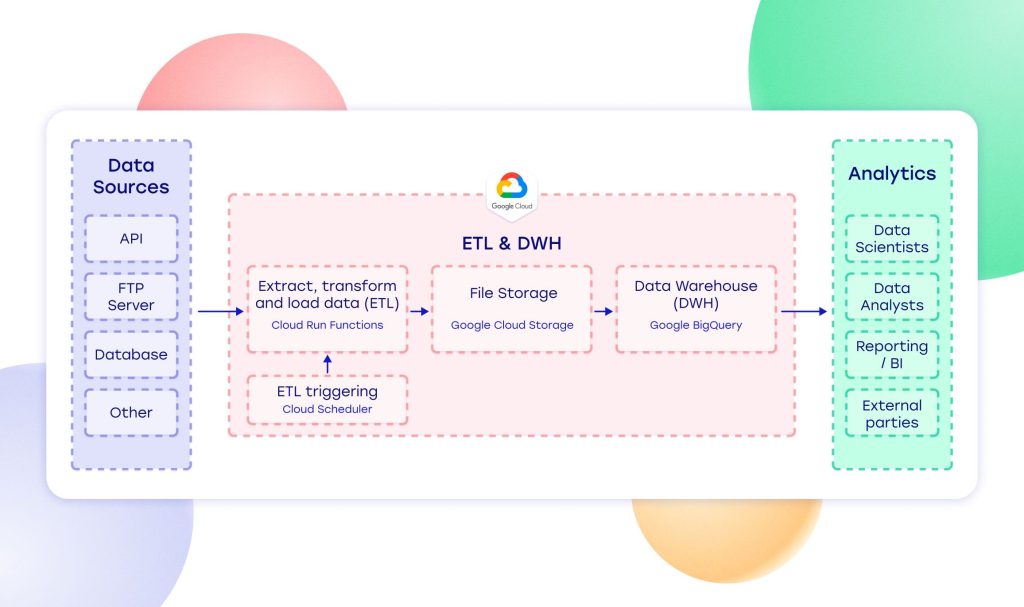Executive summary
Mainor Ülemiste, the developer of the Baltics’ largest business campus, needed a central data warehouse to support their rapid growth and smart-city ambitions. They were looking for a cost-efficient solution that would remove manual work from the process of collecting and sharing data, and allow the team members without technical expertise to access up-to-date quality data from a single location.
Helmes analyzed the needs, selected the most efficient technology, and delivered the initial data warehouse in under 3 months. The solution now automatically gathers and cleans data from various sources – including mobility, parking, building utilities, and facilities – and makes it accessible through a single, secure interface.
For us as long-time residents of Ülemiste City it was especially rewarding to know we played a big part in helping Mainor Ülemiste gain a scalable data foundation that supports daily operations strategic planning and future data science and AI initiatives.
Meet the customer

Mainor Ülemiste is developing Ülemiste City, the biggest business campus in the Baltic States, located in the vicinity of Tallinn Airport. On the 30 hectares of the campus, there are 185,000 m² of office space with nearly 400 companies and more than 18,000 people working, studying, and living on campus. The companies operating in Ülemiste City amounted to a total turnover of €2.5 billion in 2023.
Mainor Ülemiste’s goal is to develop the Smart City into the largest knowledge-based business hub in the Baltic region. The campus is developed consciously and based on data in five main categories – economy, knowledge, services, environment and community. The development project is a frontrunner in sustainability: the 2030 goals include carbon-neutral energy consumption and a car-fee campus center, while tenants can already monitor the consumption of resources by their rental space on the dedicated Green City Platform.

The challenge
To develop Ülemiste City as a smart and green business hub, Mainor Ülemiste relies on data. As the next step in their data-driven approach, the team needed a central data warehouse to consolidate data from different sources and make it accessible to stakeholders within and beyond the organization.
The client was looking for a cost-efficient solution that would remove manual work from the process of collecting and sharing data, and allow the team members to use up-to-date quality data as input for decision-making (for instance, planning mobility).
In 2023, the team turned to Helmes to find the best solution for their needs.
Our solution
Helmes’ data team provided consulting and data engineering services. We mapped and analyzed the client’s needs and proposed and implemented a data warehouse solution in less than three months, after which we continued to integrate additional data sources.
Once the initial framework of the data warehouse was set up, new data sources could be easily integrated in line with business needs. Setting up a simple new data connection without complex transformations requires, on average, 20-30 hours.
Thanks to the solution, cleaned and unified data is easily accessible to authorized users in a single web-based location, greatly facilitating data visualization, analysis and reporting. The data warehouse also opens up possibilities for data science for deriving business insights and creating future projections (including the use of AI to train models based on historical data).

The process
- Analyzing the business needs. We mapped the client’s business needs for the future solution. A data warehouse is a central repository of ready-to-use data from various sources such as APIs, FTP servers, ERP systems and files. Data is updated automatically on a daily basis without the need for manual downloading, uploading, or sharing.
- Selecting the technology. We mapped available options and decided to build the data warehouse on the Google Cloud BigQuery due to the platform’s flexibility, seamless integration with diverse data sources, scalability and low maintenance costs.
- Setting up the data warehouse. We created a data warehouse and connected it with the first set of data sources.
- Cleaning and formatting the data. An essential step in data projects is cleaning the data and harmonizing its formatting to ensure consistency in data format. This ranges from formatting of umlaut characters to matching data from different sources or comparing new entries against existing ones.
- Adding new data sources. We continued to integrate additional data sources based on the client’s needs.
Technical details
Currently, the Ülemiste City data warehouse contains the following data:
- Mobility data – People’s mobility patterns on the campus based on anonymized Telia mobile network data
- Cameras in select hotspots – Insights into how people and vehicles move on the campus (movement trajectories, type of vehicles)
- Building utility meters – Electricity, gas, central heating and water consumption of the campus buildings (the solution compares meter readings with previous ones and calculates daily, weekly and monthly usage)
- Car parking data – Car parking occupancy rates
- Bike parking data – Bike parking stations occupancy rates and bicycle parking time
- Facilities booking system – Conference room bookings, number of attendees and additional services (e.g., catering)
- CRM data – rental contracts information
GCP components used in architecture:
Cloud Run – fully managed platform that enables to run code directly on top of Google’s scalable infrastructure. In Mainor’s case, it is used to host ETL jobs as functions. One function is for calling one API endpoint (most cases).
Cloud Scheduler – executes scheduled work at defined times or regular intervals. Here, it is used to trigger ETL jobs based on a schedule
Cloud Storage – managed service for storing unstructured data. Here, it is used as an intermediate data storage between Cloud Run and DWH.
BigQuery – fully managed, serverless enterprise data warehouse solution. Mainor’s DWH is built in BigQuery.
Secret Manager – secure storage system for API keys, passwords and other sensitive data. Here, we hold user names, API keys and passwords for data source connections.
Results & benefits
The data warehouse facilitates data analysis and science by providing easy access to quality data that is updated on a daily basis. The solution’s benefits include:
- Automating time-consuming manual processes – Data is pulled automatically from different data sources, eliminating the need for manual downloads, uploads or sharing via email or spreadsheets.
- Always up-to-date quality data – The data is updated daily, cleaned and formatted consistently.
- One easy-to-use database – Users without technical expertise can easily access relevant data in a central web-based environment.
- Single source of truth –.Instead of everyone maintaining their own Excel tables with individual logic and data, the data warehouse serves as a single source of truth.
- Broad visualization possibilities – The data warehouse supports basic visualization and integrates easily with popular data visualization tools, like Power BI or Tableau.
- Scalability – The solution supports large-scale data and integrates easily with diverse data sources.
- Secure and flexible access – Only authorized users, both within and outside the organization, can access the data. Access can be restricted to specific datasets or even individual data fields.
- Low maintenance costs – The cloud-based solution is considerably more cost-efficient compared to server-based solutions.
Read also: Building an Enterprise Data Warehouse for a Norwegian E-commerce Company on Google Cloud Platform
Making data-projects hassle free
Whether it’s moving physical goods, comparing financial data to forecast the future or delving into order history to derive insights into customer profiles, making smart decisions requires easy access to up-to-date quality data.
A data warehouse serves as a central data hub, leveraging data models created by data analysts and engineers to consolidate data from multiple sources and make it easily available for data-driven decision-making. Often, it is the first step in more complex data projects, including the use of AI for achieving business goals.
Work with us
An experienced technology-agnostic partner can help you choose the best solution for your organization’s current and future data needs.
Helmes offers a full range of data and business intelligence services, from consulting to executing, tailored exactly to your specific needs. We can help you design and implement a customized data warehouse solution, along with providing ongoing support.
Get in touch




